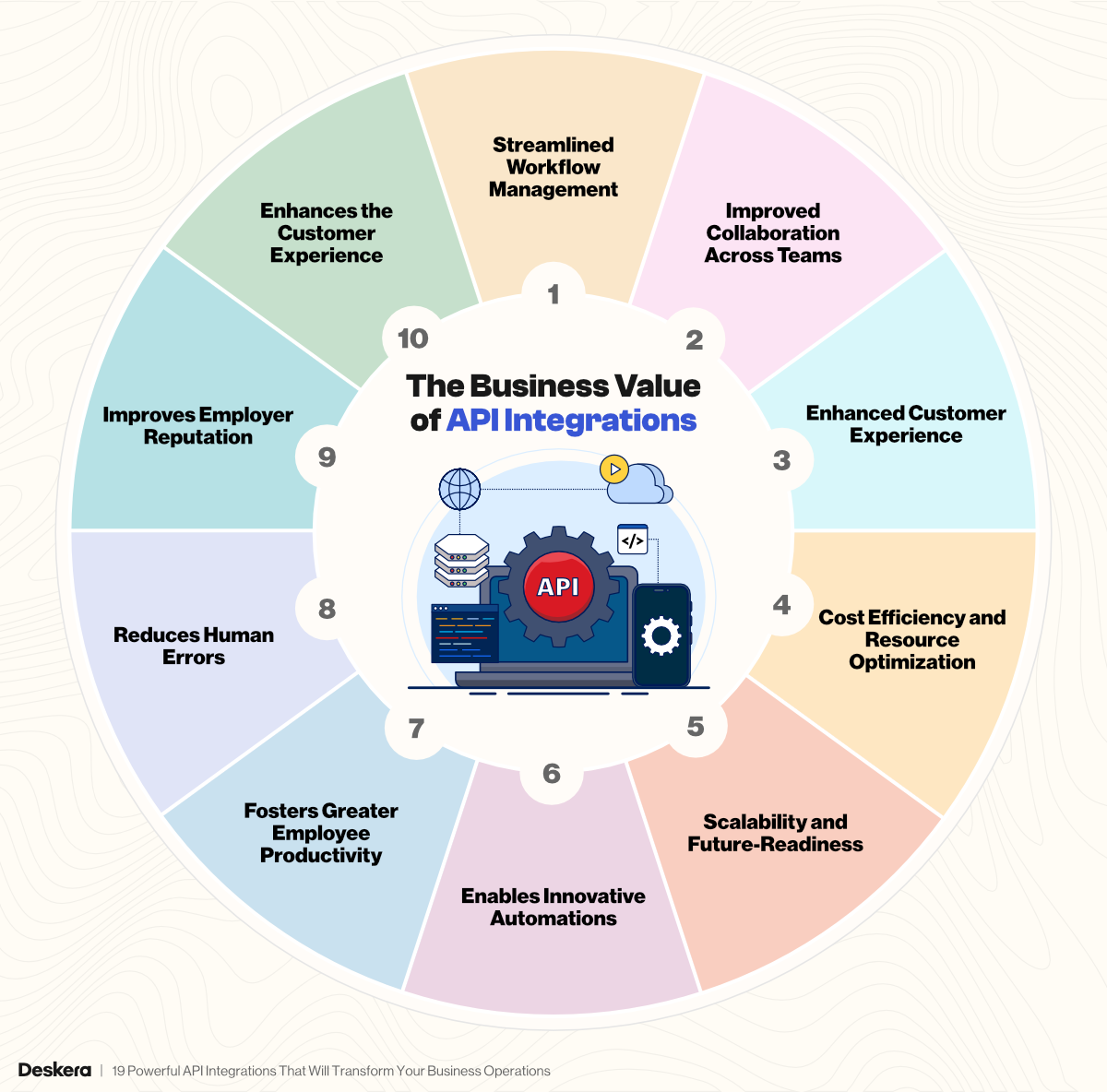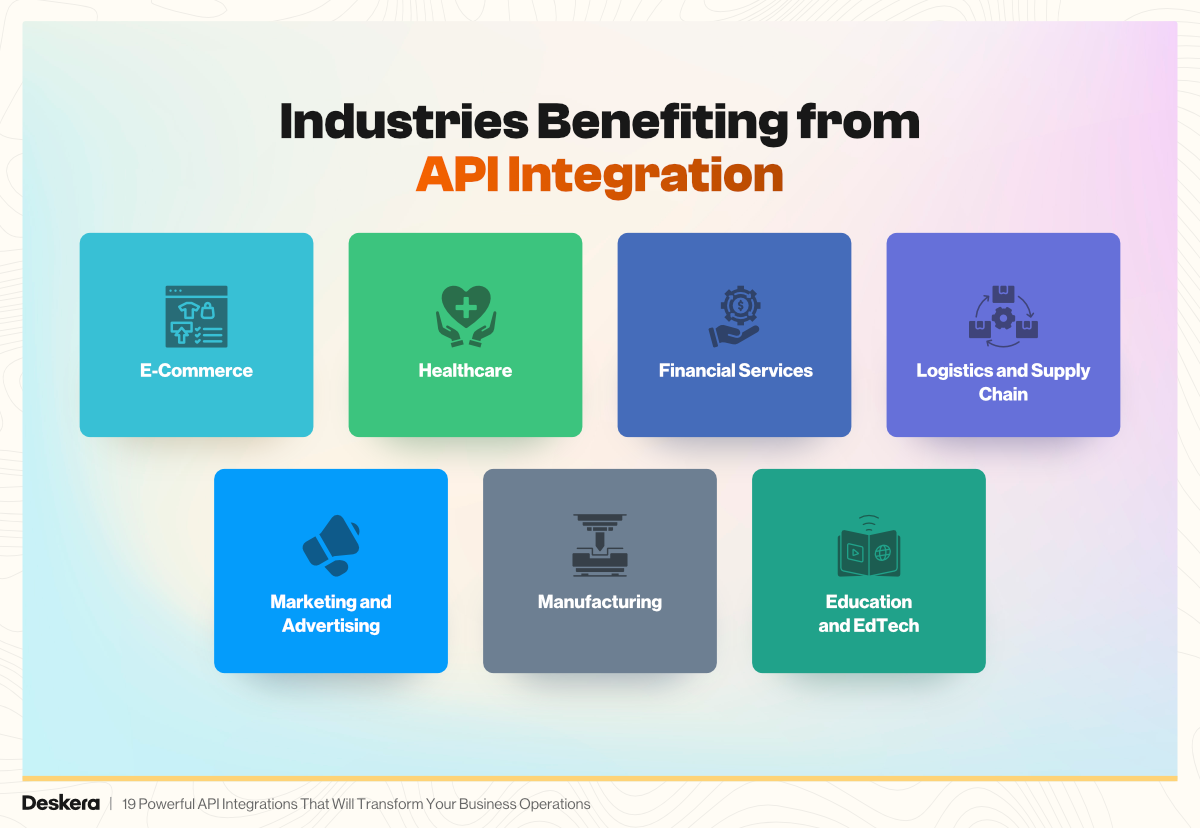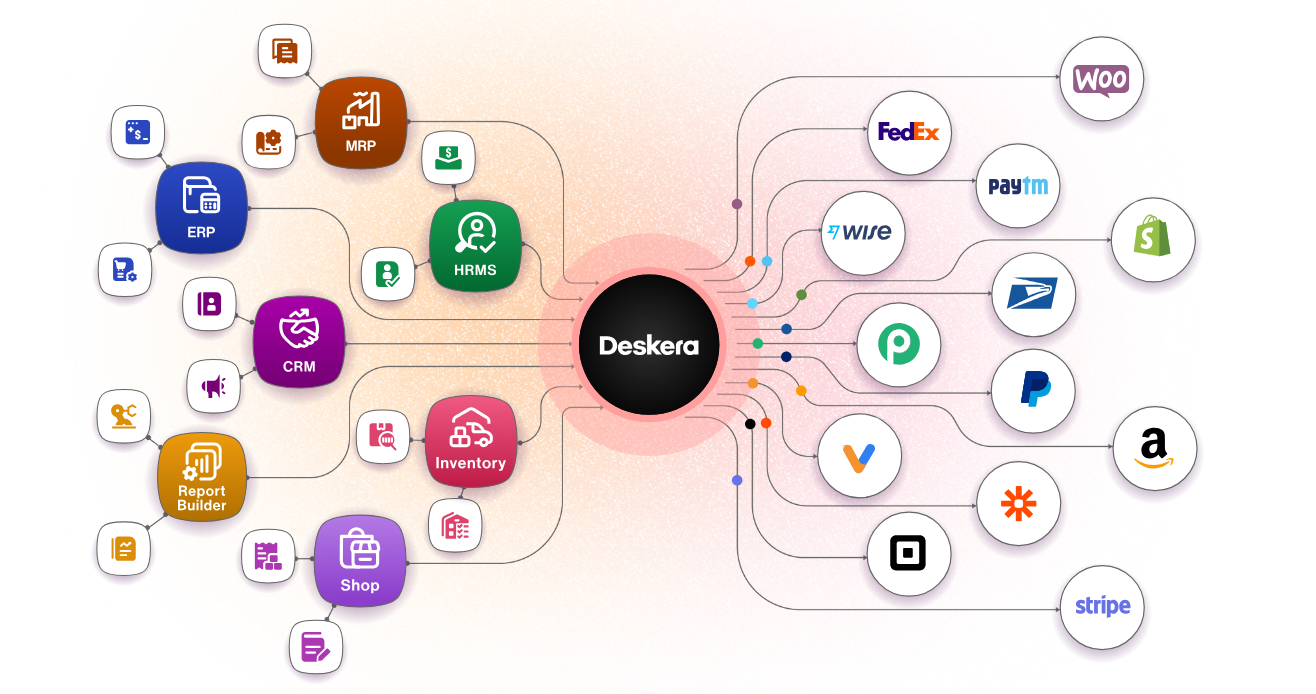APIs have become the backbone of digital business transformation, enabling companies to connect systems, automate workflows, and deliver seamless customer experiences. As organizations continue to adopt cloud-based applications and advanced software tools, the role of APIs has shifted from being a “technical nice-to-have” to a critical business enabler. The global API economy is projected to reach $267 billion by 2025, underscoring the massive potential and growth of this ecosystem.
Recent studies highlight just how integral APIs have become in modern operations. According to a MuleSoft survey, 84% of businesses now rely on APIs to streamline processes, improve integration across platforms, and accelerate innovation. From sales and marketing to finance and logistics, APIs are no longer confined to IT departments—they are central to how businesses achieve efficiency, scalability, and competitive advantage.
API integrations are particularly powerful because they break down silos and unify data across departments. Instead of manually transferring information or juggling multiple platforms, businesses can leverage APIs to create an interconnected ecosystem where every tool communicates effortlessly. This not only reduces inefficiencies but also enables smarter decision-making through real-time insights. In today’s fast-paced business landscape, the right API integrations can transform how organizations operate.
This is where solutions like Deskera ERP play a vital role. Designed for growing businesses, Deskera offers built-in integrations across finance, HR, CRM, inventory, and supply chain, helping organizations automate core processes with ease. With features like mobile accessibility, advanced reporting, and AI-powered assistance, Deskera ERP ensures that businesses don’t just adopt technology—they maximize it for growth and efficiency.
What is an API Integration?
An API integration is the process of connecting two or more software applications—whether cloud-based, on-premises, or hybrid—so they can seamlessly share information and work together as one system. At the core of this process is the API (Application Programming Interface), which defines the rules and protocols for how different applications exchange data and trigger actions. This eliminates the need for manual data entry, reduces errors, and enables businesses to run operations more efficiently.
For example, imagine an e-commerce store that receives a new order. Instead of someone manually re-entering the order details into a warehouse management system, an API integration can automatically route the order from the store’s platform to the warehouse for fulfillment. This not only saves time but also ensures accuracy in order processing and delivery.
Before APIs became the standard for software connectivity, developers had to write extensive custom code or rely on fragile scripts to link applications. Even simple tasks—like updating customer records across a CRM, ERP, and support platform—could take hours and often involved manual file transfers. With the rise of cloud computing and SaaS applications, however, APIs have become the primary method of integration, with 74% of development teams now following an “API-first” approach.
From a technical perspective, API integrations typically involve one application sending a structured request (often via lightweight web APIs such as REST) to another system, which then responds with the required data or action. Most modern APIs exchange information in JSON format for speed and efficiency, and they are secured through authentication, encryption, and access controls. For businesses, this means integrations are not only faster and more scalable but also safer and more adaptable to changing needs.
In short, API integrations create a connected ecosystem where applications—whether ERP, CRM, HR, marketing, or custom tools—can work together seamlessly. This enables real-time data synchronization, smarter decision-making, and more agile operations.
The Business Value of API Integrations

In today’s fast-paced business environment, API integrations are no longer just a technical convenience—they are a critical driver of efficiency, collaboration, and growth. By connecting disparate software applications, APIs enable seamless data flow, automation, and real-time collaboration across departments. Businesses that leverage API integrations can optimize operations, reduce errors, improve customer experiences, and position themselves for future scalability.
1. Streamlined Workflow Management
API integrations link multiple systems to ensure smooth, automated data transfer across platforms. For example:
- CRM Integration: Sync customer data with marketing tools for real-time updates.
- ERP Integration: Connect ERP systems with inventory management to prevent stock discrepancies.
Benefits: Faster workflows, reduced manual effort, and improved operational accuracy.
2. Improved Collaboration Across Teams
APIs enable different teams to share data in real-time, fostering collaboration and alignment.
Example: Marketing campaigns automatically update sales pipelines, while accounting data flows seamlessly into ERP systems.
3. Enhanced Customer Experience
APIs allow businesses to deliver personalized, seamless experiences.
- E-commerce: Integrate with payment gateways and logistics systems for smooth order processing.
- Mobile Apps: Sync with chatbots or customer support platforms for instant query resolution.
Benefit: Faster responses, accurate information, and higher customer satisfaction.
4. Cost Efficiency and Resource Optimization
By automating repetitive tasks, API integrations reduce errors and cut operational costs.
Example: A retailer automates inventory updates through APIs, minimizing labor costs and avoiding stockouts.
Benefit: Saves time, reduces manual work, and maximizes resource utilization.
5. Scalability and Future-Readiness
APIs allow businesses to grow without disrupting existing systems.
- Add new payment gateways to support international sales.
- Integrate analytics tools for real-time performance monitoring.
Benefit: Flexible operations and high performance as your business expands.
6. Enables Innovative Automations
APIs power intelligent end-to-end automations, connecting multiple platforms for complex workflows.
Example: A ticketing system sends issues to a storage solution for AI classification, assigns the ticket to the appropriate team, and notifies staff via a messaging platform.
Benefit: Faster issue resolution, streamlined processes, and improved operational efficiency.
7. Fosters Greater Employee Productivity
APIs reduce the need to switch between multiple applications, giving employees the data they need within the tools they already use.
Example: Finance teams can access sales rep details from the ERP without logging into the CRM.
Benefit: Saves time, reduces frustration, and enables focus on high-value tasks.
8. Reduces Human Errors
Automated data transfer through APIs eliminates errors caused by manual copying and pasting.
Benefit: Improved data integrity, fewer mistakes, and smoother downstream processes.
9. Improves Employer Reputation
By automating tedious tasks, employees can focus on meaningful work, increasing job satisfaction and promoting a positive work culture.
Benefit: Attracts top talent and supports employee retention.
10. Enhances the Customer Experience
Integrated systems lead to faster, more accurate responses to customer issues, while happier employees indirectly improve client interactions.
Benefit: Higher customer satisfaction and stronger client relationships.
Industries Benefiting from API Integration

API integrations are transforming how industries operate by enabling seamless data exchange, automating workflows, and enhancing customer experiences. Businesses across sectors can leverage APIs to streamline processes, improve operational efficiency, and deliver more value to their customers.
Here’s a look at some key industries benefiting from API integration:
1. E-Commerce
E-commerce platforms rely heavily on API integrations to connect payment gateways, inventory management systems, and CRM tools. This ensures that customer orders are processed smoothly, stock levels are updated in real-time, and customer data is synchronized across systems.
Benefit: A seamless shopping experience for customers and efficient operational workflows for businesses.
2. Healthcare
APIs are revolutionizing healthcare by enabling secure data sharing between electronic health records (EHRs), appointment scheduling systems, and telehealth platforms. Integration ensures that patient information is accurate and accessible to care providers when needed.
Benefit: Improved patient care, faster administrative processes, and enhanced operational efficiency.
3. Financial Services
In the financial sector, APIs facilitate secure data exchange between banks, payment processors, and accounting systems. They help organizations comply with regulations while providing seamless, real-time services to customers.
Benefit: Enhanced customer experience, secure transactions, and regulatory compliance.
4. Logistics and Supply Chain
Logistics and supply chain companies use API integrations to connect fleet management systems, warehouse tools, and tracking software. This allows real-time monitoring of shipments, optimized delivery routes, and better inventory control.
Benefit: Streamlined operations, faster deliveries, and increased transparency.
5. Marketing and Advertising
Marketing teams leverage APIs to link analytics tools, social media platforms, and content management systems (CMS). These integrations enable data-driven campaign management and automated reporting.
Benefit: Optimized marketing strategies, accurate performance tracking, and improved ROI.
6. Manufacturing
APIs help manufacturers integrate ERP, production planning, and supply chain systems. This enables real-time monitoring of production schedules, inventory levels, and equipment performance.
Benefit: Greater operational efficiency, reduced downtime, and more agile manufacturing processes.
7. Education and EdTech
Educational institutions and EdTech platforms use APIs to connect learning management systems (LMS), student information systems, and collaboration tools. This facilitates smooth data sharing and personalized learning experiences.
Benefit: Improved student engagement, streamlined administration, and enhanced learning outcomes.
19 Powerful API Integrations That Will Transform Your Operations
In today’s digital-first business environment, API integrations are essential for connecting software applications, automating workflows, and improving operational efficiency.
By linking systems such as e-commerce platforms, payment gateways, ERP, CRM, and inventory tools, businesses can reduce manual effort, minimize errors, and enhance customer experiences.
Whether it’s streamlining order fulfillment, automating payments, or synchronizing data across departments, the right API integrations can transform operations, improve decision-making, and prepare businesses for scalable growth.
Below are the key API integrations that can make a significant impact.
Payment Gateway APIs
Payment gateway APIs enable businesses to accept secure payments online, automate transaction processes, and improve customer checkout experiences.
Integrating payment systems directly with e-commerce platforms, ERP, and accounting tools reduces manual work, improves accuracy, and ensures faster payment processing. Businesses benefit from real-time reconciliation, reduced errors, and enhanced financial transparency.
1. Paytm API
Paytm API allows businesses to integrate secure online payment processing directly into their platforms. Supporting multiple payment methods like credit/debit cards, wallets, and UPI, it ensures a seamless checkout experience. Automated reconciliation reduces manual errors and improves financial accuracy.
For example, an online retailer can accept instant payments via Paytm, automatically updating transaction records and triggering order fulfillment. This streamlines operations, saves time, and enhances customer trust through fast and secure payment processing.
2. Stripe API
Stripe API enables businesses to handle online payments, subscriptions, and invoicing efficiently. It supports multiple currencies, recurring payments, and easy integration with other business systems.
For example, SaaS companies can automate monthly subscription billing while updating financial records in real-time. By reducing manual bookkeeping and payment errors, Stripe API improves operational efficiency and enhances the customer experience with secure, transparent, and smooth payment processing.
3. PayPal API
PayPal API connects businesses to the globally recognized PayPal network for secure online payments, refunds, and transaction tracking. Integrating PayPal reduces manual reconciliation and improves accuracy.
For instance, e-commerce stores can accept PayPal payments and automatically update order management systems, streamlining operations and increasing customer confidence.
This API is particularly valuable for businesses dealing with both domestic and international customers, providing a trusted, scalable solution for payment processing.
4. Wise API
Wise API automates international money transfers, providing a secure, cost-effective way to pay global vendors or remote employees. Integration with accounting or ERP systems enables automatic processing, reducing manual errors and currency conversion issues.
For example, a business can trigger vendor payments directly from its system using Wise API, improving efficiency, accuracy, and compliance with international payment regulations. It simplifies cross-border financial operations while saving time and reducing operational costs.
E-Commerce APIs
E-commerce APIs allow online stores to connect with payment gateways, inventory, CRM, and marketing tools. They enable real-time updates, seamless order processing, and better customer data management.
With API integration, businesses can streamline operations, avoid stock discrepancies, and deliver a consistent shopping experience across multiple platforms.
5. WooCommerce API
WooCommerce API connects online stores with inventory, CRM, and marketing tools. It ensures real-time updates for product listings, orders, and customer data. For example, a retailer can automatically sync stock levels with its warehouse whenever a sale occurs.
This prevents overselling, reduces manual work, and ensures that marketing campaigns reflect accurate product availability. WooCommerce API streamlines operations, improves customer satisfaction, and supports scalable e-commerce growth.
6. Shopify API
Shopify API integrates online stores with ERP, CRM, inventory, and analytics systems. Orders placed on Shopify can automatically update inventory, trigger fulfillment, and sync financial records. This eliminates manual data entry, reduces delays, and improves accuracy.
Shopify API enables seamless operations, allowing businesses to scale efficiently while maintaining consistent data across systems and enhancing customer experience.
7. Amazon API
Amazon API allows sellers to manage listings, orders, and fulfillment data on the Amazon marketplace. Integration ensures real-time inventory updates and streamlined order processing.
For example, stock levels in an ERP system can automatically adjust when a product sells on Amazon. This minimizes overselling, reduces reconciliation tasks, and improves operational efficiency. Amazon API helps businesses maintain accurate records and scale sales effectively.
8. Shop API
Shop API integrates e-commerce platforms with payment gateways, shipping providers, CRM, and analytics tools. For instance, when a customer places an order, the API updates inventory, generates shipping labels, and notifies support teams.
This reduces manual tasks, accelerates fulfillment, and ensures a seamless shopping experience. Shop API is particularly useful for businesses managing multiple sales channels.
Shipping & Logistics APIs
Shipping and logistics APIs connect carriers, fulfillment systems, and tracking tools to streamline operations. Businesses can automate label generation, track shipments in real-time, and optimize delivery processes. Integration improves operational efficiency, reduces errors, and provides better transparency for both companies and customers.
9. FedEx API
FedEx API connects shipping and logistics systems with business platforms, enabling automated label generation, rate calculations, and real-time tracking. For example, e-commerce businesses can automatically print FedEx labels when orders are placed. This improves delivery efficiency, ensures timely shipments, and enhances transparency for both businesses and customers.
10. USPS API
USPS API provides shipping, tracking, and label creation capabilities. Retailers can calculate shipping costs, track packages, and send automated notifications to customers. For example, an online store can update customers with real-time tracking information during the fulfillment process. USPS API improves operational efficiency and enhances the overall customer experience.
11. Zapier API
Zapier API allows businesses to automate workflows between multiple applications without coding. For instance, leads captured through a website form can automatically populate the CRM and trigger an email campaign. Zapier API reduces manual effort, accelerates workflows, and ensures data consistency, making cross-platform automation simple and effective.
12. Pabbly API
Pabbly API connects apps to automate tasks like updating CRM records, sending emails, or triggering invoices. For example, a purchase can automatically update the customer database, generate an invoice, and send confirmation emails. This eliminates manual intervention, minimizes errors, and enhances operational efficiency.
ERP, CRM & Business Management APIs
ERP, CRM, HRMS, and MRP APIs integrate core business systems, enabling centralized data management, automation, and real-time reporting. By connecting operations, finance, HR, and customer management systems, businesses can improve efficiency, reduce errors, and make data-driven decisions.
13. ERP API
ERP APIs integrate enterprise systems such as finance, HR, inventory, and supply chain. For example, a sales order can update inventory and financial records automatically. ERP APIs reduce manual reconciliation, improve collaboration across departments, and provide centralized insights for data-driven decision-making.
14. CRM API
CRM APIs sync customer data with sales, marketing, and support systems. Leads captured from marketing campaigns can automatically populate the CRM, triggering follow-ups and reporting. CRM API ensures data consistency, improves customer engagement, and enhances overall business efficiency.
15. HRMS API
HRMS APIs connect HR, payroll, attendance, and benefits systems. Employee attendance data can flow directly into payroll, reducing manual effort and ensuring compliance. HRMS APIs streamline HR operations, improve accuracy, and allow HR teams to focus on strategic initiatives.
16. MRP API
MRP APIs link manufacturing planning, production scheduling, and inventory management systems. For example, when raw material levels fall below a threshold, the API triggers purchase orders automatically. This optimizes production workflows, minimizes downtime, and ensures resource efficiency.
17. Report Builder API
Report Builder APIs aggregate data from multiple systems into dashboards and analytics reports. For example, sales, inventory, and financial data can be automatically compiled for real-time insights. This saves time, improves decision-making, and provides business leaders with actionable information.
18. Inventory API
Inventory APIs synchronize stock levels across warehouses, e-commerce platforms, and ERP systems. When new stock arrives, it updates all channels automatically, reducing errors and preventing overselling. Inventory APIs improve operational efficiency and enhance customer satisfaction through accurate stock management.
19. Square API
Square API integrates POS systems, payment processing, and inventory management. Sales transactions automatically update inventory and financial records, reducing manual reconciliation. Square API enables businesses to unify online and offline operations, improve reporting accuracy, and streamline daily operations.
Common Challenges in API Integration (and How to Overcome Them)
While API integrations can significantly streamline business operations, implementing them is not without challenges. Identifying potential hurdles early and applying best practices ensures smoother integration and long-term success.
Below are some of the most common challenges businesses face with API integrations and practical solutions to overcome them.
1. Compatibility Issues
Challenge: Different software systems may use varying data formats, protocols, or versions, leading to compatibility problems. For example, a legacy ERP system might not communicate easily with a modern SaaS CRM.
Solution: Use middleware or integration platforms that standardize data exchange and bridge gaps between systems. Ensure you select APIs that support widely adopted standards like REST or JSON. Testing in a sandbox environment before going live also reduces unexpected errors.
2. Security Risks
Challenge: APIs often handle sensitive data such as customer information, payment details, or proprietary business data. Poorly secured integrations can expose systems to breaches or unauthorized access.
Solution: Implement encryption, secure authentication (OAuth, API keys), and role-based access controls. Regularly audit and monitor API usage, and ensure the API provider complies with security standards such as GDPR, HIPAA, or PCI DSS.
3. Data Inconsistency and Errors
Challenge: Mismatched data formats, duplicate entries, or synchronization delays can lead to errors across systems, affecting operational decisions and customer experience.
Solution: Implement robust data validation, error handling, and automated reconciliation processes. APIs that support real-time synchronization reduce delays and ensure consistent, accurate data across platforms.
4. Scalability Limitations
Challenge: Some APIs cannot handle growing transaction volumes or increased user loads, causing performance issues as your business expands.
Solution: Choose APIs designed for scalability. Plan integration architecture to handle increased load, and monitor performance metrics regularly to anticipate bottlenecks before they affect operations.
5. Poor Documentation and Support
Challenge: Inadequate API documentation or lack of vendor support can slow down development and troubleshooting. This increases integration time and may lead to costly mistakes.
Solution: Select APIs with comprehensive documentation, active developer communities, and reliable support channels. Consider using integration platforms or pre-built connectors for faster deployment.
6. Versioning and Updates
Challenge: APIs evolve, and updates or deprecations can break existing integrations if not managed properly.
Solution: Monitor API updates from vendors and implement version control in your integration. Test new API versions in a sandbox before applying changes to production systems to ensure seamless operation.
7. Complexity of Multi-System Integrations
Challenge: Integrating multiple systems (ERP, CRM, inventory, payment gateways) can become complex, increasing the risk of errors and delays.
Solution: Map out your integration workflows carefully. Use centralized integration platforms or middleware to orchestrate multiple connections and maintain a single source of truth for critical data.
How to Implement an API Integration
API integration allows your applications to communicate with each other seamlessly. Implementing it effectively requires careful planning, technical setup, and testing to ensure smooth data flow between systems. Here’s a step-by-step guide:
1. Identify Business Requirements
Before implementing an API, define what you want to achieve with the integration. Ask questions like:
- Which systems need to communicate?
- What data needs to be shared (e.g., orders, inventory, customer information)?
- Which processes can be automated?
Document these requirements to guide the integration process and ensure the solution addresses real business needs.
2. Choose the Right API
Once requirements are clear, select the appropriate API(s) that match your objectives. Consider:
- Type of API (REST, SOAP, GraphQL)
- Security protocols (OAuth, API keys)
- Documentation quality and support
- Compatibility with existing systems
For example, if you want to automate payments, you might choose a Stripe or PayPal API; for inventory updates, an ERP API may be more suitable.
3. Obtain Access Credentials
Most APIs require authentication to ensure secure data transfer. Depending on the API, you may need:
- API key
- OAuth token
- Client ID and secret
Secure these credentials and avoid hardcoding them in your application to prevent unauthorized access.
4. Understand the API Documentation
API documentation provides essential information, including:
- Endpoints (URLs to access specific data or actions)
- Request methods (GET, POST, PUT, DELETE)
- Required parameters and payloads
- Response formats (JSON, XML)
- Error handling
Reading the documentation carefully reduces integration errors and helps design effective workflows.
5. Develop the Integration
This step involves coding or configuring your system to connect with the API:
- Direct coding: Developers write scripts or use SDKs provided by the API provider.
- No-code/low-code platforms: Tools like Zapier, Pabbly, or Integromat allow connecting apps with minimal coding.
Ensure the integration includes error handling, data validation, and logging to track any issues.
6. Test the Integration
Before going live, thoroughly test the API integration:
- Send test requests and check responses
- Verify that data is correctly transmitted and updated across systems
- Simulate edge cases, errors, and failures
- Ensure security measures like encryption and authentication work correctly
Testing ensures that the integration is reliable and reduces disruptions when deployed.
7. Deploy and Monitor
After successful testing, deploy the integration into the production environment. Monitor it closely to ensure:
- Data flows correctly
- Performance is stable
- No errors or failures occur
Use dashboards or logging systems to track API activity and performance, allowing proactive troubleshooting.
8. Maintain and Update
APIs evolve over time, so continuous maintenance is critical:
- Update the integration when API versions change
- Adjust workflows if business requirements evolve
- Monitor performance metrics and error logs regularly
This ensures long-term stability and scalability of your API integrations.
Tools like Deskera ERP simplify API integrations by providing pre-built connectors for ERP, CRM, inventory, and accounting modules. This reduces coding effort and accelerates implementation, allowing businesses to automate processes quickly and reliably.
Best Practices for API Integration
API integrations can transform business operations, but to maximize their benefits, it’s crucial to follow best practices. Proper planning, security, and ongoing monitoring ensure that integrations remain efficient, reliable, and scalable. Here are the key practices businesses should adopt:
1. Choose the Right APIs
Not all APIs are created equal. When selecting APIs, ensure they align with your business goals and can integrate seamlessly with existing systems. Consider factors such as functionality, documentation quality, support, and compatibility.
Choosing the right API reduces development time, minimizes errors, and ensures that your integration delivers measurable business value. For example, selecting a payment API that supports multiple currencies can help businesses scale internationally without disruptions.
2. Prioritize Security
APIs often handle sensitive business and customer data, making security a top priority. Use encryption protocols, authentication methods like OAuth, and access controls to protect data.
Regular security audits and vulnerability assessments help maintain the integrity of your integrations. Secure API integration reduces the risk of data breaches, protects customer trust, and ensures compliance with data protection regulations like GDPR and HIPAA.
3. Focus on Scalability
Business needs evolve, so your APIs should accommodate future growth. Scalable APIs allow you to handle increasing data volumes, new workflows, or additional integrations without performance issues.
For instance, integrating a CRM with an ERP system via a scalable API ensures that adding new modules or automating additional processes won’t disrupt existing operations. Planning for scalability reduces the risk of costly rework later.
4. Monitor Performance
Regularly monitoring API performance helps identify and resolve issues proactively. Use tools like API analytics platforms or monitoring dashboards to track uptime, latency, error rates, and usage patterns.
Performance monitoring ensures that data flows smoothly, integrations remain reliable, and potential bottlenecks are addressed before they impact business operations.
5. Work with Experts
API integration can be complex, especially when dealing with multiple systems and workflows. Partnering with experienced developers, integration specialists, or API consultants ensures that your integration is designed and implemented correctly.
Experts can optimize performance, handle edge cases, and troubleshoot issues efficiently, saving time and reducing the risk of costly mistakes.
6. Maintain Comprehensive Documentation
Document your API integration processes, endpoints, data flows, and error-handling procedures. Comprehensive documentation helps teams understand the integration, simplifies onboarding of new developers, and facilitates troubleshooting. Well-documented integrations reduce dependency on specific personnel and ensure continuity even as teams change.
7. Test Thoroughly Before Deployment
Before going live, test your integrations extensively under various scenarios, including edge cases, high load, and error conditions. Thorough testing ensures that data is transmitted correctly, workflows function as expected, and the integration remains stable under real-world conditions. Continuous testing reduces downtime and prevents costly errors in production.
8. Plan for Versioning and Updates
APIs evolve over time, so it’s important to plan for version upgrades and changes. Monitor API updates from providers and ensure that your integration can adapt without disruption. Proper versioning and update management prevent failures, maintain compatibility, and keep integrations future-proof.
Platforms like Deskera ERP simplify API integration by offering pre-built connectors, reducing the need for extensive coding, and enabling businesses to automate workflows quickly and securely.
How to Choose the Right API Integrations for Your Business
Selecting the right API integrations is critical for maximizing efficiency, minimizing errors, and achieving your business goals. With hundreds of APIs available across payment processing, e-commerce, ERP, CRM, and more, making an informed choice ensures seamless operations and long-term scalability.
Here’s a step-by-step guide to help you choose the right API integrations for your business:
1. Define Your Business Needs
Start by identifying the specific challenges or goals your business wants to address with API integration. Ask questions like:
- Which systems need to communicate?
- Which processes are time-consuming and could benefit from automation?
- What data needs to flow between applications?
Clearly defining your requirements ensures that the chosen APIs align with your operational objectives and deliver measurable value.
2. Evaluate API Functionality
Assess the features and capabilities of potential APIs. Consider whether the API can:
- Support your required workflows
- Handle the volume of transactions your business generates
- Provide real-time data synchronization
For example, if you’re an e-commerce business, an API that updates inventory and processes orders in real time will be far more valuable than one that only offers basic reporting.
3. Consider Compatibility with Existing Systems
Ensure that the API can integrate seamlessly with your current software stack. Compatibility with ERP, CRM, inventory, or payment systems is critical to avoid custom workarounds and potential disruptions. Choosing APIs that easily connect with your existing tools saves time, reduces errors, and ensures smoother adoption.
4. Prioritize Security and Compliance
Since APIs often handle sensitive data, security should be a top priority. Look for APIs that provide:
- Encryption for data in transit and at rest
- Authentication protocols like OAuth or API keys
- Compliance with regulations such as GDPR, HIPAA, or PCI DSS
Secure integrations protect your business and customer data, building trust and minimizing risk.
5. Evaluate Scalability
Your business needs will evolve, so choose APIs that can scale as your operations grow. A scalable API can handle increasing transaction volumes, additional users, or expanded functionalities without compromising performance. Planning for scalability prevents future headaches and ensures long-term reliability.
6. Assess Vendor Support and Documentation
A well-documented API with strong vendor support makes integration easier and faster. Look for:
- Clear, detailed documentation and code examples
- Active developer communities or forums
- Responsive support channels
Strong support helps your team troubleshoot issues quickly and ensures smooth implementation.
7. Test Before Full Implementation
Many APIs offer sandbox or test environments. Use these to:
- Verify data flows correctly
- Simulate real-world usage
- Identify potential errors or limitations
Testing before going live minimizes risks and ensures the integration will work as intended.
8. Track ROI and Performance
After implementation, continuously monitor the API’s performance and business impact. Metrics to track include:
- Reduced manual effort
- Error reduction
- Faster workflows
- Enhanced customer satisfaction
Tracking performance ensures that the API continues to meet your business goals and helps you make adjustments if needed.
Solutions like Deskera ERP offer pre-built API integrations for ERP, CRM, HRMS, and inventory systems. This allows businesses to implement secure, scalable, and automated workflows quickly, minimizing the technical burden while maximizing operational efficiency.
Future Trends in API Integration
API integrations are evolving rapidly, driven by digital transformation, cloud computing, and the increasing need for seamless connectivity across business systems. As businesses adopt more applications and automation, the role of APIs will continue to expand.
Here are some key trends shaping the future of API integration:
1. API-First Development
More businesses are adopting an API-first approach, where software is designed with integration in mind from the outset. This enables modular, flexible systems that can easily connect with new tools, third-party applications, and emerging technologies. API-first development ensures future scalability, reduces custom development time, and allows faster deployment of business solutions.
2. Increased Automation and Intelligent Workflows
APIs will drive more advanced automation, connecting multiple systems for end-to-end workflows. Intelligent integrations powered by AI and machine learning will allow businesses to automate complex processes such as predictive inventory management, personalized customer experiences, and automated ticketing. This reduces manual work, improves accuracy, and accelerates operational efficiency.
3. Real-Time Data and Analytics
The future will see APIs enabling more real-time data sharing between systems, supporting faster and data-driven decision-making. Businesses will gain instant insights into sales, inventory, customer behavior, and financial metrics, allowing them to respond quickly to market changes and operational challenges.
4. Cloud-Native and Serverless Integrations
As more businesses move to cloud-native applications, APIs will increasingly be built for serverless architectures. This allows scalable, high-performance integrations with minimal infrastructure overhead, reducing costs and improving reliability. Cloud-native APIs enable businesses to deploy and scale integrations globally with ease.
5. Enhanced Security and Compliance
With APIs handling sensitive business and customer data, there will be a stronger focus on security standards, encryption, and regulatory compliance. Future integrations will incorporate advanced authentication, anomaly detection, and continuous monitoring to safeguard data while enabling secure cross-platform connectivity.
6. Low-Code and No-Code API Platforms
Low-code and no-code integration platforms will continue to grow, empowering non-technical teams to create and manage API workflows. This democratization of API usage allows businesses to implement integrations faster, reduce dependency on IT teams, and scale automation across departments efficiently.
7. Expansion of API Marketplaces
API marketplaces are becoming more common, offering businesses pre-built integrations for payments, CRM, ERP, logistics, and analytics. These marketplaces accelerate deployment, reduce development effort, and help companies adopt best-in-class tools without starting from scratch.
8. AI-Powered API Monitoring and Optimization
Future API platforms will leverage AI to monitor usage patterns, predict failures, optimize performance, and automatically adjust workloads. This proactive approach ensures reliability, reduces downtime, and enhances the overall efficiency of API-driven workflows.
How Deskera ERP Can Help You With API Integration?

Deskera ERP is designed to streamline business operations by providing a comprehensive suite of APIs that connect core systems like ERP, CRM, HRMS, MRP, inventory, reporting tools, and payment gateways. By leveraging Deskera’s APIs, businesses can automate workflows, improve collaboration, and gain real-time visibility across departments. Here’s how Deskera ERP can transform your operations:
1. Seamless Integration Across Systems
Deskera ERP APIs allow you to connect ERP, CRM, HRMS, MRP, inventory, and reporting systems, eliminating data silos. For example, when a new sales order is created in CRM, the API automatically updates inventory and triggers production planning in MRP. This ensures consistent data across all systems, reducing manual effort and errors.
2. Automate Payments and Financial Workflows
With Deskera’s payment gateway APIs, including integrations with Paytm, Stripe, PayPal, and Wise, businesses can automate invoicing, payment collection, and reconciliation. Transactions are securely processed, and financial records are updated in real time, saving time and minimizing errors while ensuring compliance.
3. Streamline E-Commerce Operations
Deskera ERP provides APIs for e-commerce platforms like WooCommerce, Shopify, Amazon, and Shop, enabling automatic synchronization of orders, inventory, and customer data. Businesses can avoid stock discrepancies, process orders faster, and provide a seamless shopping experience, all without manual intervention.
4. Simplify Shipping and Logistics
Deskera APIs integrate with carriers like FedEx and USPS, allowing automatic shipment creation, label printing, and tracking updates. For example, when an order is placed, the API can generate a shipping label, update the status in the ERP, and notify the customer automatically. This ensures timely delivery and operational efficiency.
5. Enhance Reporting and Analytics
With Deskera’s Report Builder and Inventory APIs, businesses can consolidate data from multiple systems and generate real-time insights. Automated dashboards help managers track KPIs, monitor inventory, and make informed decisions quickly, without switching between platforms.
6. Boost Collaboration and Productivity
Deskera ERP APIs connect departments such as sales, finance, operations, and HR, facilitating real-time data sharing. Employees can access the information they need within the applications they use daily, reducing redundant tasks, avoiding manual data entry, and improving overall productivity.
7. Scalable and Future-Ready
Deskera ERP APIs are designed to grow with your business. Whether adding new payment gateways, connecting additional e-commerce platforms, or integrating advanced analytics tools, Deskera ensures that your operations remain seamless and scalable.
By leveraging Deskera ERP’s pre-built API integrations, businesses can automate critical workflows, reduce human errors, and focus on strategic growth, making it a comprehensive solution for modern business operations.
Key Takeaways
- API integration connects multiple software applications, automating data exchange and workflows, which reduces manual effort, minimizes errors, and allows businesses to operate more efficiently.
- API integrations streamline workflows, enhance collaboration, improve customer experience, reduce costs, and make business operations scalable and future-ready.
- From e-commerce and finance to healthcare and logistics, API integrations empower diverse industries to automate processes, improve accuracy, and deliver superior customer experiences.
- Leveraging APIs like payment gateways, e-commerce platforms, shipping carriers, ERP, CRM, HRMS, and inventory tools allows businesses to automate key processes and achieve seamless, real-time operational efficiency.
- Challenges like compatibility issues, security risks, data inconsistencies, scalability limits, and poor documentation can be overcome with careful planning, monitoring, and leveraging pre-built integration platforms.
- Successful API integration requires careful planning, selecting the right API, secure authentication, thorough testing, and ongoing monitoring to ensure reliability and efficiency.
- Choosing compatible, secure, and scalable APIs, maintaining documentation, monitoring performance, and working with experts ensures seamless integration and long-term success.
- Businesses should evaluate API functionality, compatibility, security, scalability, vendor support, and ROI potential to select integrations that align with their operational goals.
- API-first strategies, intelligent automation, low-code platforms, enhanced security, cloud-native architectures, and AI-assisted monitoring will shape the next generation of business integrations.
- Deskera ERP provides pre-built, scalable APIs across ERP, CRM, HRMS, MRP, inventory, e-commerce, and payment systems, enabling businesses to automate workflows, reduce errors, and gain real-time visibility.
Related Articles

















